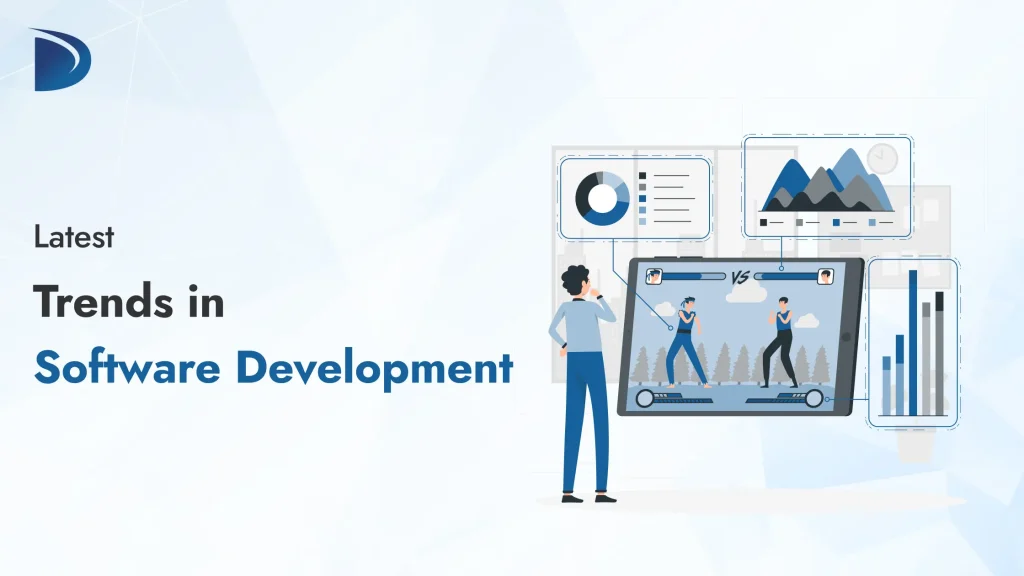Table of Contents
Software development is growing fast. New updates and tools keep changing how apps and digital products are made. It’s not just about writing code, but about doing things quicker and smarter. The latest trends in software development show that teams want to save time and achieve good results. New platforms and features help cut long steps and bring better ways to work.
This shift isn’t just happening in big tech. Startups and small teams are also moving forward using tools that used to be hard to access or use. Recent market research says software will cross $1 trillion in value by the end of 2025. The push comes from more demand for apps, automation, and web-based services.
This growth connects directly to how people live and work. Software is used everywhere, every day, from shopping to health and transport.
Before discussing the trends, it helps to consider what’s changing. People want things faster, easier, and made for real-life use, which is the main reason these trends matter.
Top 8 Latest Trends in Software Development to Watch
1. Continued Growth of Progressive Web Apps (PWAs)
Progressive Web Apps (PWAs) are increasingly favored for seamless user experiences across mobile and desktop platforms. They function like native apps but are quicker to develop and can operate directly in browsers without downloading. Their cost-effectiveness and rapid deployment are leading more companies to adopt PWAs.
The market for Progressive Web Apps stood at roughly USD 1.46 billion in 2023. It’s on track to expand rapidly through 2030, growing at a 31.1% annual rate. This rise comes as more users seek faster, app-like experiences without downloading.
Industries benefiting from PWAs include:
- Retail: For fast, install-free online shopping.
- Media: For enhanced offline access and swift content delivery.
- Hospitality: For mobile-first booking and customer service.
Key advantages:
- Operates offline or on low-speed networks.
- Faster page loads and improved user engagement.
- More cost-effective compared to developing separate Android and iOS apps.
2. Wider Adoption of Blockchain Across Industries
Blockchain technology is expanding beyond the financial sector, with various industries leveraging it to maintain transparent records, prevent tampering, and securely share data without intermediaries. Its decentralized nature helps reduce fraud and enhances accountability.
The global blockchain technology market was valued at USD 27.85 billion in 2024 and is projected to grow from USD 44.29 billion in 2025 to USD 746.41 billion by 2032, exhibiting a CAGR of 49.7% during the forecast period.
Common industry use cases:
- Healthcare: Secure storage of patient data and fraud reduction.
- Supply Chain: Real-time tracking of product origins and statuses.
- Legal: Storage of contracts as smart agreements.
Reasons businesses prefer blockchain:
- Helps reduce data breaches.
- Eliminates single points of failure.
- Builds trust between parties without third-party control.
3. 5G Driving Innovation in Software and Devices
The rollout of 5G technology is revolutionizing software development, particularly in applications requiring real-time interaction and large data transfers. Its high speed and low latency enable enhanced app performance utilizing video, sensors, and connected devices.
Statista said there were around 2.1 billion active 5G subscriptions worldwide in 2024, nearly double the previous year. As global demand increases, this number is expected to grow steadily and reach close to 5.5 billion by 2029.
Industries benefiting most from 5G software development:
- Healthcare apps: For remote diagnostics and real-time data transmission
- Gaming companies: For cloud-based multiplayer gaming experiences.
- AR/VR platforms: For seamless, real-time visual experiences.
What 5G supports in software:
- Enhanced video streaming and conferencing quality.
- Faster app downloads and updates.
- Real-time AI-driven features in mobile applications.
4. Growth of Internet of Things (IoT) in Every Sector
The Internet of Things (IoT) is increasingly integrated into daily life, from home automation to industrial machinery. Data collected through connected devices improves decision-making and automation across various industries.
In 2023, the Asia Pacific IoT market made USD 311,067.9 million, with hardware being the top-selling part. By 2030, it is expected to grow to USD 842,219.0 million, rising steadily at a 15.3% yearly growth rate from 2024 to 2030, according to Grand View Research.
Key trends shaping IoT:
- Digital twins: Virtual models replicating real-world machines or systems.
- Smart cities: Utilizing sensors for traffic control, public safety, and waste management.
- Healthcare monitoring: Wearables for continuous patient data tracking.
Challenges and solutions:
The proliferation of devices increases security risks.
- To address this, companies are implementing blockchain-based protections to manage device data securely.
5. Low-Code Development Becoming the Default in Many Projects
Low-code platforms empower developers and business users to create applications using visual tools, reducing the need for manual coding. This approach accelerates testing and deployment, particularly for smaller projects or internal tools.
The global low-code development platform market was valued at approximately USD 24.8 billion in 2023 and is projected to reach USD 167.0 billion by 2030, growing at a CAGR of 31.4% during the forecast period, according to a report by P&S Intelligence
Why low-code works:
- Facilitates faster application launches.
- Reduces hiring and training costs.
- Simplifies updates and scaling.
Best used in industries like:
- Banking: For internal automation tools.
- Education: To rapidly develop learning apps and portals.
- Healthcare: For scheduling systems or feedback collection apps.
Popular low-code platforms:
- Microsoft Power Apps
- Zoho Creator
- Mendix
- Appian
6. Steady Growth of AR/VR in Real-World Applications
Augmented Reality (AR) and Virtual Reality (VR) are moving beyond entertainment into areas like training, retail, and healthcare. These tools help simulate experiences, visualize products, and improve user interaction.
According to Grand View Research, the global VR market reached USD 59.96 billion in 2022 and is set to grow at a 27.5% CAGR through 2030. VR uses headsets and other tools to create 3D experiences, which are now common in gaming, entertainment, and training. It’s also widely used for skill-building in fields like aviation, defense, and engineering.
Key AR/VR use cases:
- Retail: Virtual product try-ons and showroom experiences
- Training: Immersive simulations in medical or industrial fields
- Real estate: Interactive 3D walkthroughs
Why businesses are adopting it:
- Boosts engagement with immersive UX
- Reduces physical resource needs in training or demos
- Supports remote collaboration with 3D environments
7. Cross-Platform Development Tools Gaining More Attention
Companies now seek to cut costs by building once for multiple platforms. Tools like Flutter, React Native, and Xamarin support apps that work on both Android and iOS with a single codebase.
According to Verified Market Reports, the cross-platform game engine market was valued at USD 6.25 billion in 2024 and is expected to reach USD 12.45 billion by 2033, growing at a CAGR of 8.5% from 2026 to 2033.
Why gaming studios prefer cross-platform tools:
- Faster development and updates
- One codebase for all platforms
- Consistent gameplay and graphics
Used widely in:
- Indie studios: For multi-device game launches
- Mid-size game companies: To lower development costs
- eLearning platforms: For interactive training games
8. Integration of AI in Software Architecture Design
AI is now used to support software architecture decisions, helping teams choose structures, manage system complexity, and plan services. It’s applied in new and existing systems to improve speed, accuracy, and maintainability. AI models assist in mapping dependencies and predicting design flaws.
According to UnivDatos, the AI Architecture Design Software Market reached USD 4.1 billion in 2022 and is set to grow at about 16.2% annually through 2030. This rise is supported by increasing interest in more innovative design tools, better AI features, and stronger demand for eco-friendly planning.
How users benefit:
- Quicker updates and better app performance
- Fewer design bugs in deployed systems
- Systems that adjust more easily to new needs
How architects benefit:
- Auto-suggestions for better system structure
- Easier transitions between architecture styles
- Less manual work in documenting and reviewing design
Conclusion
The latest trends in software development show how teams are moving toward faster, simpler ways to build digital products. With new tools and platforms, small and large businesses are making better apps without extra time or cost.
From AI to low-code tools, these latest trends in software development are shaping how people build and use technology every day. They support smarter decisions, flexible tools, and industry updates.

